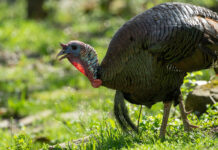When my wife and I left on vacation July 21, I felt pangs of guilt. I had been hosting a growing number of ruby-throated hummingbirds at my feeders since early May.
Young birds had begun using the feeders in early July. Using the formula hummer banders suggest, I counted the most hummingbirds I could see at any one moment (12) and multiplied by five. That suggested a total of 60 hummers were visiting my backyard before we left. I made sure the feeders were full that morning, but I know they’d be drained by the end of the day.
Guilt
The nagging guilt I felt was whether any hummers would still be around when we got home. We returned about 7:30 p.m. July 28, and I immediately cleaned and refilled the feeders. By 9 p.m. I hadn’t seen a single hummer. I feared my hummer summer might be over.
The next morning I took a cup of coffee onto the porch and waited. Cardinals, towhees and Carolina wrens provided background music, and at exactly 7:28 a.m. an adult male zipped to one of the feeders. Satisfied that at least one hummer returned, I went about a variety of chores the rest of the day. During that time I saw a few more birds, but not nearly the numbers that I had seen before our trip.
When I got up Wednesday morning, about 36 hours after our return, the hummingbird activity picked up. Within just a few minutes, I could count five or six hummers at once. By noon, hummer numbers had returned to nearly what they had been before vacation. Those results did not surprise me. Hummingbirds are obviously very mobile and easily fly a mile to a reliable food source.
In nature, they return to productive nectar patches after depleting them. They know that flowers can replenish nectar supplies in just a day or two, so it seems they treat nectar feeders the same way.
If you’re having a good hummingbird year and plan to travel this month, chances are your hummers will return shortly after you do. Just clean and fill the feeders, and give the hummers 24 to 48 hours.
In the meantime, here’s some information to make your hummingbird season more enjoyable. Feeding hummingbirds is like feeding seed-eating birds. It’s not necessary. Birds can find plenty of natural foods. But by offering nectar to hummingbirds we can attract them to places where we can watch and enjoy them.
Recipe
The recipe for hummingbird nectar is simple. Mix one part table sugar with four parts boiling water, cool, and refrigerate. Do not use artificial sweeteners or honey to make nectar. Hummers need the calories table sugar provides, and honey promotes the growth of a fungus that can kill hummingbirds. Because most nectar feeders have bright red parts, red dye is an unnecessary ingredient.
I’m often asked if commercially prepared nectar is better than the homemade recipe made with table sugar. Boxed mixes are OK, but expensive compared to ordinary table sugar. I prefer to make my own nectar. Boxed nectar mixes often advertise that they are fortified with vitamins and minerals, but hummingbirds satisfy their nutritional requirements from natural foods, including soft-bodied invertebrates such as spiders, aphids and flies, which make up at least 50 percent of their diet.
Other products that might tempt you are jugs of what appears to be premixed nectar. But if you read the label, you’ll find that some of these products require added sugar.
It’s just colored water that lacks the most important and expensive ingredient. Another tip to pull in the early arrivals is to get one or two hanging baskets for the porch near the feeders.
Flowers
Colorful flowers, especially red ones, may attract attention when a single feeder does not. And when fruit spoils, don’t throw it out.
Place it in the hummingbird garden. Fruit flies and other small insects will quickly be attracted to rotten bananas, and hummers eat these soft-bodied invertebrates.
Insects provide the protein and nutrients that nectar lacks.
Finally, consider planting a few nectar-rich plants in the backyard. Scarlet bee balm, trumpet honeysuckle, trumpetcreeper and jewelweed can turn any backyard into a hummingbird magnet.













Thank you for your post. I’ve been stressing about taking down the feeders while we’re gone on vacation. I’ve been having the same fears as you, that they wouldn’t come back. But I’d hate to make any of them sick by leaving out our feeder which will get moldy before we get back. Thanks for the info.
Hah I have hummingbird guilt now,, glad your story had a happy ending!
It’s good to learn that young hummingbirds usually start using feeders around July. My wife and I are wanting to make our backyard feel more alive and we were wondering when we should put out some hummingbird feeders. I’ll be sure to tell her that we should put feeders out around the month of July.
Thank you. I too, was a bit concerned about leaving the house and taking down the feeders.
I was afraid my hummers will leave, we are going away for two weeks in a few days and I don’t have anyone to clean and fill their feeders. Seems safer to empty them and refill when I get home…
It’s been so hot and I don’t want their nectar to spoil.
This is all such great information! Thank you!
Omg! Thank you so much for this post. I am leaving on vacation today the 15th and just took the hummers feeders down as I will be out till the 26th and they are all flying around looking for them. It broke my heart. I really hope that they return when I come back they bring me so much joy!
I felt the same way! I took mine down and had a hummingbird hover in front of the window like “hey, where’s my feeder?”! But when I got back and hung my feeder back up they came back. I think it took a few days but they all came back.
Yes I am going away for 6 days and have about 7 Hummingbirds and I guess I’ll take the feeders in. I just want my babies to return. I feel a little better but sad.
I was nervous to go on a 10 day vacation. I have 5 feeders and 40 hummingbirds regularly feeding. Glad to know I can go on vacation and not worry that the hummers will die.
I’m glad I found this post.. we are snowbirds and we are leaving Arizona soon. I have guilt suddenly taking down my feeders. I have one little hummer that favors a feeder. I was wondering if I should slowly take them down.. for like a week, less hours each day. But just knowing they’ll find other food sources makes me feel better!